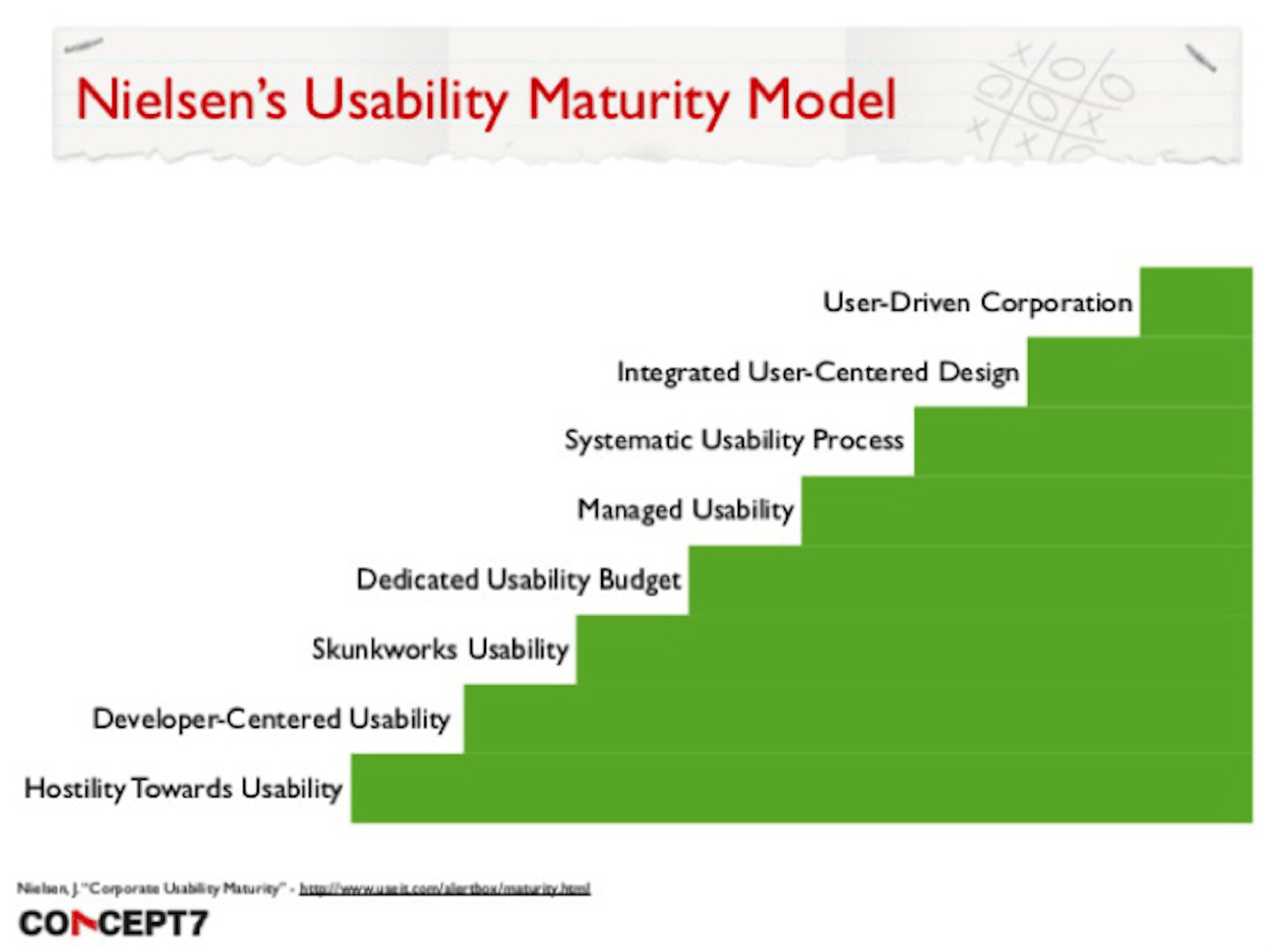
How mature is your approach to UX?

How mature is your organization's approach to UX? By understanding your organization's current commitment to users, you can make decisions that will lead to stronger company investment in UX resources down the line.
High commitment to user research and design practices is what helps elevate companies like Apple, IBM, Nike, and Disney. It might take a long time and require some effort, but prioritizing UX is certainly worthwhile.
Stages of UX Maturity
Researchers have categorized UX maturity in different ways in recent years, but all approaches have commonalities. Let’s look at a few models to understand how a company’s UX culture typically evolves.
First, Nielsen’s stages of maturity focus on how a company prioritizes usability —progressing from hostility to full acceptance. A pair of 2006 articles by Dr. Jakob Nielsen describe this process as eight stages: four early stages followed by four later stages of UX maturity.
- Stage 1: Hostility Toward Usability — The company focuses on building working products with no regard to usability.
- Stage 2: Developer-Centered User Experience – The company relies on their own (faulty) intuition rather than user research to make design decisions.
- Stage 3: Skunkworks User Experience – The company does some user research as needed, but without sufficient planning or budgeting.
- Stage 4: Dedicated UX Budget – The company funds and plans for user research, but UX activities are still sparse.
- Stage 5: Managed Usability – The company has a dedicated UX employee to lead efforts, but the UX budget is possibly unstable or limited.
- Stage 6: Systematic User-Centred Design (UCD) Process – The company incorporates UX research and iterative improvements throughout projects, with enough budget to sustain important projects.
- Stage 7: Integrated User-Centred Design – The company invests more heavily in early user research and in tracking usability metrics, injecting UX into the span of the design lifecycle.
- Stage 8: User-Driven Corporation – The company looks to user research results to determine priorities and company direction beyond product design alone.
Concept7 created a visual for Nielsen’s 8 stages of UX maturity…

Second, let’s look at a condensed model of similar ideas. In Jared Spool’s talk Beyond the UX Tipping Point, he identifies a five-stage progression of organizational UX:
- Dark Ages – Resources are dedicated solely to business and technology.
- Spot UX Design – There are some UX projects with limited success.
- UX Design as a Service – A UX team is available in house as needed.
- Embedded UX Design – The UX team has dedicated UX resources.
- Infused UX Design – Even non-UX team members have UX skills, so the entire team is designing!
Jared Spool frames his talk around the example of the Walt Disney Parks and Resorts company. Between 1997 and 2014, Disney advanced from having a barely usable website for buying park tickets to debuting the Magic Bands— wearable devices that provide a seamless guest experience for park ticketing, hotel room access, restaurant reservations, and more.
A big leap, to be sure, but it took many years for Disney to achieve this result.

A slide from Jared Spool’s Beyond the UX Tipping Point talk emphasizes Walt Disney Parks and Resort’s evolution from Dark Ages — a horribly unusable website in 1997 —to Infused UX Design — the wearable Magic Bands introduced in 2014.
How can you push your company’s UX maturity forward?
To progress UX maturity, leadership needs to possess both a good attitude toward user-centered processes and the practical resources (budget and time) to support these practices.
An organization can gradually become more user-centered as it grows, but it takes a lot of dedication to get there.
If your organization has no UX advocate, you may need to leap forward and be that person. Dr. Jakob Nielsen suggests taking small UX steps rather than taking a big, giant leap into UX. Build on these wins and build trust within your organization to slowly improve your company’s UX.
Here are some more tips for improving your UX leadership skills and pushing the UX maturity needle forward:
- Companies that are hostile or ignorant about user needs will be hard to sway, so capture some quick wins to begin building a case for your work.
- Get good at broadly talking about the value of UX research.
- Have answers ready to common excuses for ignoring UX needs.
- Gain allies and followers in your company who also see your vision of higher UX maturity.
- Aim to involve UX as early in a project’s lifecycle as possible.
- When in later maturity stages, justify increased investment by communicating the impact of UX processes on ROI, team productivity, conversions, or other business metrics.
- Please don’t be discouraged if progress is slow — it often takes a decade or two for a company’s UX culture to fully mature, and a company can stay in one stage for years.
- Once a company achieves a level of maturity, it can still regress to a lower level. It takes continuous effort, communication, and strategy to keep UX a priority.





